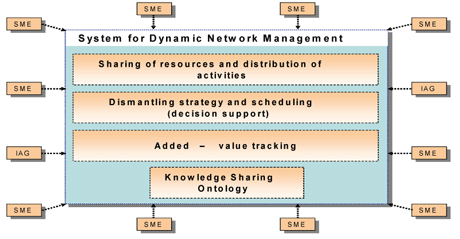Recycling and reuse of End-of-Life Vehicles (ELV) are among the most challenging issues faced by Europe in maintaining sustainable development and decreasing pollution, energy use and material consumption. The main roles in this field are played by several hundreds (or even thousands) SMEs (Small and Medium Enterprises). The E-Mult project (European Multi-threaded Dynamic SME Networks for Market-Driven ELV Recycling - suggests a systematic approach to solving these problems by using networked, multi-agent systems with advanced knowledge management supports.
Our goal is to achieve operating, multi-threaded, agent-based multiregional and transnational networks of SMEs, working together in the European ELV recycling industry using highly dynamic business models. We shall provide innovative solutions in the form of a set of free software Building Blocks (BB) of an open and highly scalable architecture, an agent-based platform for operation of dynamic networks of SMEs, including a powerful distributed decision-support system for network management, and infrastructure for knowledge sharing. The consortium consists of academic and SME partners from Poland (coordinator), Germany, Spain, Austria, Estonia, Holland and Hungary, and IAGs (Industrial Associations Groups) have become involved in order to assist in broader application of the results.
The main Objectives are Derived from Industrial and Eco-Political Needs
In 2000, the EU accepted directive 2000/53/EC to address European waste management, within which a dedicated framework document handles the ELV issue. At the moment, 75% of the metal content of end-of-life vehicles is recycled. The aim of this directive is to increase the rate of reuse and recovery to 85% by average weight per vehicle per year by 2007 and 95% by 2015, and to increase the rate of reuse and recycling over the same periods to at least 80% and 85% respectively. In order to satisfy these requirements, SMEs must have supporting tools and a methodology that will allow them to efficiently run highly sophisticated, complex operations in a strongly interrelated and networked manner.

In developing a methodology and a platform to support SMEs organizing dynamic cooperative networks, our approach is to combine agent-based technology with adaptive, rule-based reasoning and statistical methods. Based on analyses of the needs of SMEs, we concluded that to meet the strategic objectives of SMEs the principal problems to be solved are the following (Figure 1):
- An innovative autonomous, low-cost, multi-layer, multi-agent platform should be established; such a flexible and reliable technology for distributed decision support and knowledge sharing will be used to implement the innovative procedures for managing networks combined with a number of other services, and to assure high interoperability. The project result provides an agent-based platform combining different types of agents to support communication and management within SME-driven networks.
- A set of innovative procedures and algorithms should be created for effective network management based on a combination of probabilistic reasoning, product/process models and statistical methods. These will solve three key problems in the management of dynamic networks of SMEs:
- optimal sharing of resources and distribution of activities within networks
- adaptive algorithms for real-time decision-making on dismantling strategy and scheduling of shop floor operations
- tracing and measuring added values along the recycling chains to solve the critical issue of harmonization between added value in multi-threaded, 'backward' (collection, dismantling) processes and 'standard' added value within forward processes in the production of products using recyclates.
- A methodology should be elaborated to identify optimal enterprise models of multi-threaded, dynamic networks of SMEs, where both economic and ecological/legislative aspects, and complex interactions between processes and market needs are taken into account.
- Methods and tools for knowledge management (KM) should be defined, combining heuristic reasoning and models, using agent technology and including representations of experience-based knowledge.
Case Studies: Experimental Test Networks/Business Cases
There will be two experimental clusters of cooperating SMEs within the project. The BC1 environment will serve as a validation of the potential business benefits envisaged by the project. SMEs will implement the E-Mult System in order to demonstrate the full prototype of international vertical dynamic networking. This implies the cooperation of the complete supplier-dismantling-customer supply chain.

Within the BC2 environment, SMEs will demonstrate the full prototype of international horizontal dynamic networking, aiming to provide recycled materials for new products in day-to-day operation with all BC2 SMEs. Since profitable business is naturally an outcome of selling second-hand parts, any part of an ELV that is currently requested should be instantly accessible. However, if the part is not immediately required, it might be risky to invest time and energy to separate it, since the scrap metal market can instantly pay for metals and other valuable materials by their volume or weight. Storing parts for long periods consumes resources (warehouse capacity), handling effort, manual operations etc. ELV dismantlers will therefore try to operate an SME network between themselves and the car repair shops from which the demand for replaceable spare parts originates. Networking the sale of scrap metal is also beneficial for SMEs, since they are able to negotiate for better prices with the large scrap-material handlers.
Conclusion
A new, more effective cooperation/collaboration networking environment will be offered for European ELV dismantling, reuse and recycling SMEs. The network will function as a cooperative supply and demand network, and will be realized as a multi-threaded, multi-agent system.
Link:
http://195.187.100.149/emult/
Please contact:
György Kovács
SZTAKI, Hungary
Tel: +36 1 279 6140
E-mail: gyorgy.kovacs![]() sztaki.hu
sztaki.hu
Géza Haidegger,
SZTAKI, Hungary
Tel: +36 1 279 6207
E-mail: haidegger![]() sztaki.hu
sztaki.hu










